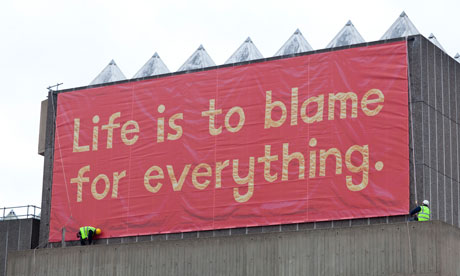
Exhibition of the Week: Jeremy Deller
Art is alchemy. Who can say why one work of art lives and another dies? Why one artist can create images that take flight while another works assiduously at producing entropic stuff? Or why art that once seemed magical suddenly seems gross? Like I say – it's an alchemical process that defies logic.
The most alchemical British artist of my generation is Jeremy Deller. This curator of social happenings has none of the conventional attributes of an artist at all. He does nothing by the book – this is, for instance, the first proper gallery exhibition of his works. His most famous creations are events and performances that involved large numbers of people: a brass band playing acid house anthems, getting hundreds of historical re-enactors from the Sealed Knot society dressed as miners and police to fight a battle from the miners' strike years after the original clash took place.
My own favourite Deller action was Unconvention, an exhibition in Cardiff that juxtaposed fandom for the Manic Street Preachers with some of the 20th century's greatest art. It was a kind of secret history of the modern world, as also is Acid Brass, which connects different aspects of the industrial revolution and its impact on northern England.
How is any of this art? There is, I say, an alchemy that goes on when Deller teams up contrasting groups of people and releases unexpected meanings and memories through what might be called controlled social explosions. He is an engineer of human fission and fusion. Because the stuff of his art is so ethereal – the starlight of human beings ourselves – it is curiously uplifting.
I see him also as a history painter. Deller studied baroque art at the Courtauld Institute. His human canvases actually have the majesty and sweep of 17th-century paintings such as Rembrandt's The Night Watch. Or, if you shun such historical parallels, we can compare him with Joseph Beuys, who also wove magic in the social world, and summoned history and memory in a self-conscious art of shamanism.
Jeremy Deller, a shaman? Let's just say he is one of the most authentic and important artists of modern Britain and leave it at that.
At Hayward Gallery, Wednesday 22 February until 13 May 2012
Also opening
Charline von Heyl
Abstract painting today is epitomised by this New York-based artist.
• At Tate Liverpool from 24 February until 27 May 2012
Dreams of Here
Three artists – Julian Bell, Tom Hammick and Andrzej Jackowski – offer different visions of what painting and drawing can be now.
• At Brighton Museum and Art Gallery until 10 June 2012
Joseph Wright of Derby
A newly refurbished permanent gallery for this museum's outstanding collection of works by a great British artist.
• At Derby Museum and Art Gallery from 25 February 2012
Idris Khan: The Devil's Wall
A multimedia reflection on the Hajj.
• At Whitworth Art Gallery from 24 February until 13 May 2012
Masterpiece of the week
Donatello, The Ascension, 1428-30, at The V&A Museum, London
The awe-inspiring power of illusion in art is unleashed to devastating emotional effect in this great sculpture. Perspective – the mimicry of real space in a picture, with objects receding into the distance – was new when Donatello carved this in early 15th-century Florence. Many of the most potent early expressions of perspective appear in pictorial ("relief") sculptures such as this one, partly because Florentine craftsmen trained in metalwork or masonry were fascinated by the idea of recreating the sculpture they saw on Roman sarcophagi, and partly because the revelation of deep space in art could be all the more dramatic in relief, rendered in stone, metal or terracotta.
On the left of Donatello's gathering of disciples, the receding rank of bodies is like a vista of a colonnade. It is a delighted demonstration of perspective. Yet this is not for one second a cold or calculated exercise.
For the beauty of this work of art lies in the way Donatello, right at the start of the perspective picture, uses his command of space and proportion to achieve a new kind of emotive power. The figures are organised in a moving and authoritative way. There is a sense of truth, and reality, that grabs you and cuts into you. The faces are harrowed, almost like faces in a Black Painting by Goya. The soft finish of the marble give it a mysterious atmosphere. It is a gripping monument of grief and faith, a profound work that wrenches the gut.
Image of the week
What we learned this week
That Jeremy Clarkson could do with getting into Picasso
That Charles Saatchi thinks we should free the Turner 30,000
How candid Juergen Teller can be
Why Thandi Sibisi is making art-scene waves in South Africa
That Damien Hirst is getting into eco-home design
Lastly …
Sign up for the Art Weekly newsletter

